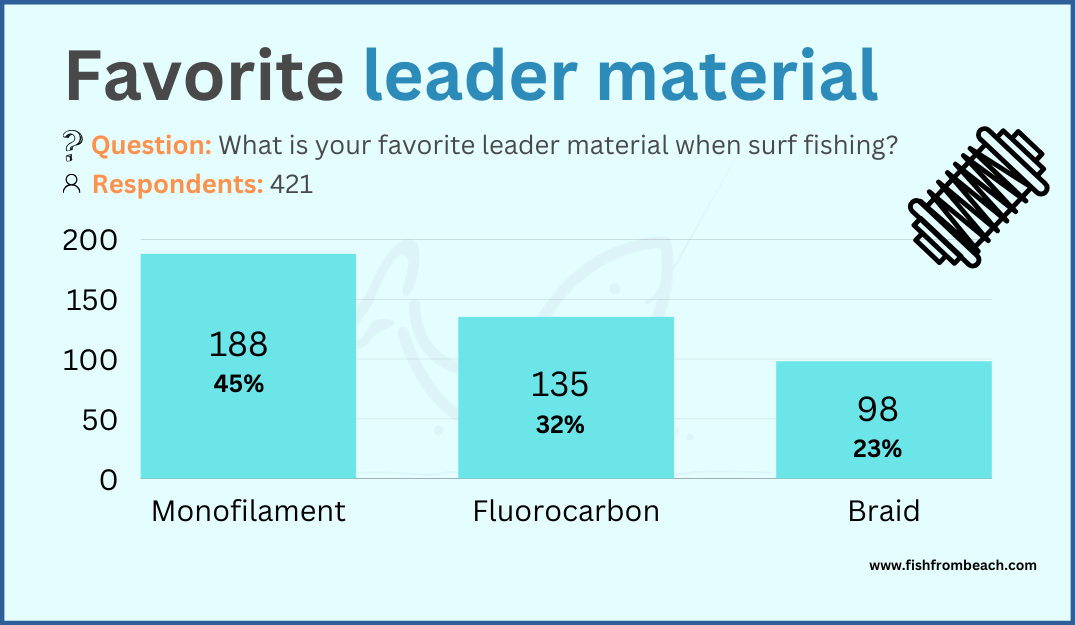Leaders play an extremely important role when surf fishing. A poor choice can easily result in a mediocre catch count, while a well-selected leader can be incredibly rewarding.
One important question when choosing a surf leader is which material yields the best results?
The choices are numerous here. Fluorocarbon, monofilament, braid, and wire.
All of these materials can be used for surf fishing leaders. Each has its advantages and pitfalls, and each suits certain conditions and objectives. But which one is the best for surf fishing?
That’s what we will address today. In this article, we will cover the different factors to consider when selecting a material for surf leaders, as well as explore the pros and cons of mono, braid, fluro, and wire leaders.
So without further talk, let’s dive in.
A quick answer
The best leader materials for surf fishing are fluorocarbon and monofilament. Both are hard to see underwater and resist well to abrasion, which makes them ideal for most surf fishing conditions. Fluoro works best for bottom-feeding and wary fish, while mono is the way to go for large targets.

The different surf fishing leader materials
Monofilament leaders
One of the most commonly used leader materials for surf fishing is monofilament.
The main advantage of monofilament is its high stretch capacity, which allows the leader to absorb high-tension moments and reduce the risk of cut-offs.
Moreover, monofilament provides a high knotting strength, which gives your terminal setup more durability and resilience.
Another feature of monofilament is its ability to float, which helps keep the bait a few inches above the seabed. This can be highly rewarding when targeting fish species that prefer their food to be suspended in the water.
Finally, monofilament is highly abrasion-resistant and hard to see in the water, which makes it a great leader material for surf fishing.
Fluorocarbon leaders
Fluorocarbon is a popular leader material for surf fishing thanks to its excellent abrasion resistance and low visibility underwater.
As mentioned above, monofilament also possesses these two features. However, fluorocarbon scores better ratings at both.
In other words, fluorocarbon is the best option when targeting wary fish that may get hesitant upon seeing your line. It’s also the ideal choice when dealing with highly abrasive structures or when targeting sharp-toothed fish like sharks and bluefish.
Additionally, fluorocarbon is denser than monofilament, which helps it sink deeper in the water body. This can be helpful when targeting fish that pick up food from the seafloor such as pompano and redfish.
In addition, fluorocarbon is not as stretchy as monofilament. This offers anglers more sensitivity when detecting bites, setting hooks, and fighting fish.
Worth noting also that fluorocarbon is more expensive than monofilament. This can be a significant factor for fishermen who go on numerous trips every month.
Braid leaders
Braid is not a common leader material for surf fishing, primarily because of its limited abrasion resistance, which makes it vulnerable in many situations.
Even when fishing in an abrasion-free environment, braid remains a poor choice for surf leaders because it’s highly visible underwater, which can affect the bite count.
Additionally, braid offers zero stretch, which can pose problems when dealing with heavy fish, as there will be nothing to absorb the huge pressure such fish generate during fights.
Another reason why braid leaders are not commonly used in surf fishing is that they are hard to break.
As a good rule of thumb, your leader should be lighter than the line it is attached to. This way, when your hook gets tangled and you apply force to break free of the snag, you want the leader to snap first because that’s the cheapest option.
If the line (or shock leader) breaks first, you can’t predict where the cut-off will occur, potentially resulting in a significant loss of line.
Here, and besides the associated costs, it’s not environmentally friendly to leave a lot of line in the ocean.
Perhaps the only advantage that braid leaders provide is the higher breaking strength for a given diameter. This can be helpful when facing strong currents that apply so much pressure on your terminal gear.
Here, choosing braid for your leader can help keep your bait where you want it to be.
However, I believe the risk of losing your leader due to abrasion and the other issues we just discussed outweighs the risk of getting drifted by heavy currents.
So, braid can be an option when surf fishing in open waters with minimal abrasive structures or when targeting aggressive predators that don’t mind seeing the line. Otherwise, I would always opt for fluorocarbon or monofilament.
So which leader material for surf fishing?
After exploring the pros and cons of mono, fluoro, and braid leaders, the answer is now pretty clear.
The best leader materials for surf fishing are monofilament and fluorocarbon.
Mono and fluoro are quite similar in the features they exhibit, so either choice will work just fine. However, if you want to maximize your productivity and reap the maximum benefits from each material, here are the use cases for both monofilament and fluorocarbon leaders.
When to use monofilament leaders?
- When targeting large fish: Monofilament provides more stretch than fluorocarbon and therefore helps to absorb the massive stress large fish create during fights. This reduces the risk of snaps and therefore helps to land heavier fish.
- When you need a floating bait: Monofilament has a greater floating capability and is, therefore, the preferred choice when you want your bait to stay a few inches above the bottom.
- When your budget is tight: Monofilament is cheaper than fluorocarbon and therefore allows you to save a few bucks in the tackle store. This has more significance if you fish quite often.
When to use fluorocarbon leaders?
- When underwater visibility is critical: Fluoro is nearly invisible underwater and is, therefore, an ideal choice when fishing crystal clear waters or when targeting cautious fish.
- When it’s too abrasive where you cast: Fluorocarbon is the most abrasion-resistant option and is, therefore, the way to go when surf fishing rough and rocky grounds or when sharp-toothed fish are around.
- When targeting bottom feeders: Fluoro sinks deeper in the water body and therefore can help to target the species that feed at the bottom.
- When targeting small fish: Fluorocarbon is more sensitive than monofilament. This helps to detect more bites from small fish, which are the most common catch in the surf.
As for braid, due to its poor resistance to abrasion and high visibility underwater, it’s not a recommended choice for surf fishing.
You can’t rely on that for your last inches of line.
The answers we received in our surf fishing survey endorse this. When we asked 421 of our readers about their favorite material for surf leaders, monofilament claimed the top spot with 45% of the votes, indicating its widespread usage for leaders.
Fluorocarbon ranked second, garnering 32% of the preferences, thanks to its advantageous properties such as low visibility and high abrasion resistance.
Braid, although less favored, still secured a notable 23% of the votes.

What about wire (steel) leaders?
There is a fourth leader material called wire or steel. It’s not widely used for surf fishing, but some fishermen opt for it, especially when targeting sharks and other large predators.
The main advantage steel leaders provide is their high breaking strength and unmatched abrasion resistance, which makes them a great tool to deal with an extremely abrasive environment.
Personally, I don’t like wire leaders for numerous reasons.
First of all, they are highly visible underwater. This can significantly reduce the number of bites you get, especially when you are not only targeting large fish.
Second, the stiff nature of steel leaders has a negative impact on your bait presentation. Instead of letting the bait move naturally with the current, steel leaders give a robotic, unnatural motion to the bait, raising the concerns of the fish.
Also, wire leaders are less flexible and can easily bend and turn into curly shapes. This increases the risk of line twists and tangles, hence affecting your productivity.
And finally, steel leaders are thick and therefore receive more pressure in agitated surf zones. This prevents your bait from staying where fish hold.
Typically, you should use steel leaders only when:
- There are sharks and other toothy fish within your casting range.
- You are interested only in large fish.
- It doesn’t bother you to scare the other species with a highly visible leader.
Other than that, I would simply use a 60-100 lbs monofilament leader. This should deal with the most abrasive conditions.
We covered a lot of tips like this in our ebook “101 tips for surf fishing“. This guide will answer all your surf fishing questions and spare you a lot of research and experimentation. I encourage you to give it a try.
Note (*): If you make a purchase through links from this website, we may get a small share of the sale from Amazon or other similar affiliate programs.
Surf Fishing Survey
Help us provide you with better content by answering simple questions about your surf fishing experience and knowledge.
We will put the collected responses together and turn them into valuable information that will help you catch more fish from shore 😉
Note: No personal information will be collected with your answer.
